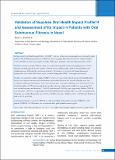Please use this identifier to cite or link to this item:
https://hdl.handle.net/20.500.14356/1768| Title: | Validation of Nepalese Oral Health Impact Profile14 and Assessment of Its Impact in Patients with Oral Submucous Fibrosis in Nepal |
| Authors: | Rimal, J Shrestha, A |
| Citation: | Rimal J, Shrestha A. Validation of Nepalese Oral Health Impact Profile14 and Assessment of Its Impact in Patients with Oral Submucous Fibrosis in Nepal. J Nepal Health Res Counc. 2015 Jan-Apr;13(29):43-9. PMID: 26411712. |
| Issue Date: | 2015 |
| Publisher: | Nepal Health Research Council |
| Article Type: | Original Article |
| Keywords: | Oral submucous fibrosis Oral cancer Oral health Oral potentially malignant disorders Quality of life |
| Series/Report no.: | Jan-April, 2015; |
| Abstract: | Abstract Background: Oral Health Impact Profile-14 (OHIP-14) is one of the most internationally used oral health related quality of life (OHRQoL) questionnaire available in various languages. The study was aimed to validate Nepalese version of OHIP-14 and to assess impact of quality of life (QoL) in patients with oral submucous fibrosis (OSF). Methods: An interventional OHRQoL study was conducted among OSF patients visiting Department of Oral Medicine and Radiology, BP Koirala Institute of Health Sciences, Dharan using OHIP-14 after translation and validation process. Following the baseline questionnaire, 74 patients were treated with dexamethasone and hyaluronidase for 6 weeks and followed up for 6 months during which OHIP-14 was again administered. Results: For concurrent validity, Nepalese OHIP-14 scores were associated with self-perceived oral health status, self-perceived dental treatment need and satisfaction with oral health status. For internal reliability, inter-item correlation coefficient varied from 0.2-0.8. Corrected item-total correlation coefficients were between 0.43-0.80. Cronbach's alpha was 0.90. Commercial tobacco product chewing with arecanut (Gutka Ⓡ ) was seen among 45% with median frequency and duration of 7.5(0-20) times/day and 10(0-60) years, respectively. Median OHIP-14 score at baseline 18(0-45), was significantly (p<0.001) different from 6 months' follow-up [5(0-15)]. Impact score at baseline was mainly influenced by age (r(s) =0.32, p=0.005), frequency of habit (r(s) =0.44, p<0.001) and duration of habit (r(s) =0.31, p=0.006). s Conclusions: Nepalese version of OHIP-14 is a valid and, reliable instrument to measure OHRQoL in OSF patients. OHRQoL in OSF patients can be improved after professional treatment regime. Keywords: Oral submucous fibrosis; oral cancer; oral health; oral potentially malignant disorders; quality of life. |
| Description: | Original Article |
| URI: | http://103.69.126.140:8080/handle/20.500.14356/1768 |
| ISSN: | Print ISSN: 1727-5482; Online ISSN: 1999-6217 |
| Appears in Collections: | Vol. 13 No. 1 Issue 29 January - April 2015 |
Files in This Item:
| File | Description | Size | Format | |
|---|---|---|---|---|
| 43_49.pdf | Fulltext Download | 245.23 kB | Adobe PDF |  View/Open |
Items in DSpace are protected by copyright, with all rights reserved, unless otherwise indicated.
